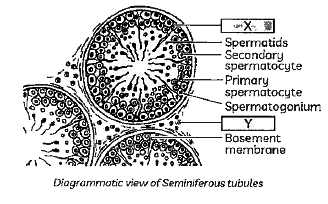Which provides nutrition to maturing sperms?
A
Leydig cells
B
Scrotum
C
Epididymis
D
Sertoli cells.
Video Solution
Text Solution
The correct Answer is:D
|
Answer
Step by step video, text & image solution for Which provides nutrition to maturing sperms? by Biology experts to help you in doubts & scoring excellent marks in Class 12 exams.
Updated on:21/07/2023Topper's Solved these Questions
Similar Questions
Knowledge Check
The innermost wall layer of microsporangia which provides nutrition to the developing pollen grain is
AEpidermisBEndotheliumCMiddle layerDTapetumA mature sperm has
AA pair of flagellaBA nucleus , an acrosome and a centrioleCA nucleus , an acrosome , a pari of centriolesDA nucleus , an acrosome , a pair of centrioles and a tail .Identify the cells that provide nutrition to the germ cells.
ASertoli cellsBLeydig cellsCSerniniferousDSepta
Extra structure that provides nutrition to embryo is
View SolutionWhich cell or gland of earthworm provides the nutrition to unfertilize eggs?
View SolutionWhich cells in human testis provide nourishment to developing sperms?
View SolutionSynergids provide nutrition to the embryo sac in Seam by
View SolutionObserve the given diagram and find out the correct statement:

(I) X are Sertoli cells
(II) Y are Leydig cells
(III) X provides nutrition to spermatocytes
(IV) Y provides nutrition to spermatocytes
View Solution
